Mother Earth isn't always so nice: When All Life Almost Died 252 Million Years Ago
In the old mythologies, there are often two companions who created the world and/or were parents to the gods that followed. Often the father was associated with the sky and the mother with the world or Earth. Earth Mother, Mother Earth or even Mother Nature all stem from this basic memetic ancestry. In recent years though, Mother Nature has been portrayed as a loving, caring maternal figure. This is probably because much of life has become so tame, at least in the natural sense, compared to what our ancestors faced. Few of us, at least in the West, have to worry about a bear eating us, a pack of wolves stalking us, or a a saber toothed tiger trying to make off with our kids. Hopefully, no one has to worry about that last! Here in America, if its not trying to eat us, we tend to idealize it. Bambi and Disney might be the strongest expression of it, but Mother Nature has taken on a kindly aspect.
Except when it comes to her occasional storm or earthquake, we have largely learned how to insulate our lives from Mom's mean side. And Disney's portrayal of Mother Nature as sweet and kind is another, to be sure. However, Mother Nature isn't the Disney version. In the past, Mother Nature has brutally murdered vast swathes of life, rendering whole lineages extinct. Seen a long necked sauropod dinosaur lately? Or how about the lemur-like primates native to North America? Now and then, the murders she commits are above and beyond even mass murder: they are the mass extinctions.
Mass extinctions are when vast arrays of life, huge swathes, are wiped out. Not just of a single kind, like amphibians, nor is that life confined to just a single area or even a continent. Mass extinctions kill everything, everywhere, world wide. Some survive - or we would not be here - but in varying degrees all kinds of life are impacted. This includes plants, animals, microbes, plankton, fungi and more. Everything takes a bit to one degree or another. Everywhere takes a hit as well, some lightly, but others get utterly devastated.
What causes mass extinctions has varying over time. The most famous is the KT or K-Pg Extinction that ended the Mesozoic and rendered the nonavian dinosaurs extinct (but not them alone). That was caused by a massive meteor impacting the Yucatan Peninsula in Mexico at Chicxulub. The two previous mass extinctions we have discussed, the Ordovician and the Devonian, were caused by a broken ecological cycle combined with a massive glaciation: life poisoned the seas and then the glaciers sucked up water to force life into the deadly waters. Those was far from the first mass extinctions, but they along with the Permian, End Triassic, K-PG/KT and Holocene Mass extinctions make up the largest extinction events in the last 550 million years, a time frame known as the Phanerozoic Eon.
This post is going to discuss the next chronological mass extinction of the Phanerozoic, the End Permian or Permian Triassic Mass Extinction. There was at least one more mass extinction prior to this, the Guadalupian Mass Extinction, but it was significantly smaller than the PT Event. The Carboniferous Rainforest Collapse may count as well, but research is still ongoing there. However, amongst the mass extinctions, the mass murders by Mother Earth of her children, the Permian Extinction stands head and neck above the others of the Phanerozoic. It was the moment when life almost died out on Earth and it's causes were rather different than those of the Ordovician or Devonian Mass Extinctions.
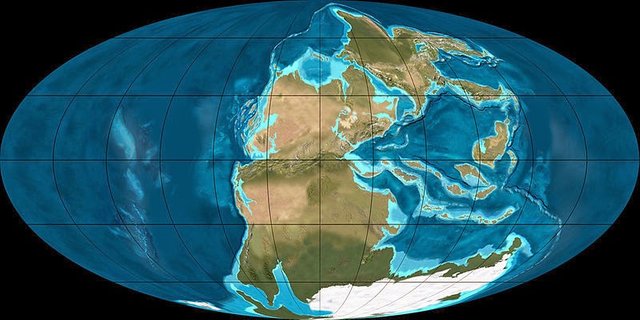
Permian Map of the World, img src: Geology Page
The world and ecology of just prior to the mass extinction event that reset so much was an in evolutionary revolution. There were giant saber toothed animals, the gorgonopsids, that were relatives of mammals, but distantly so as the top predator around the world. Some were as large or larger than grizzly bears. There were beaked mammals relatives known as dicynodonts that were one of the primary types of herbivore for the time. There were near mammals called therocephalians, at least one of which had an actually poisonous bite. There were giant reptilian animals called the pareiasaurs, that looked so much like giant turtles, it was thought for a long, long time they were relatives, if vastly larger. The first gliding vertebrates were present, but no vertebrates had figured out how to fly and would not do so until the pterosaurs tens of millions of years later. There were also the ancestors of mammals and dinosaurs.
Life was booming. It was weird. It was different. It was, honestly, exciting. However, all of that came to an abrupt and terrible end. Death came for over 90% of all life in the oceans. The oceans were nearly rendered back to anoxic, microbial life alone. If not for a few refuges, refugea in scientific parlance, the oceans could have been rendered a toxic mess close to permanently. The vast majority of land animals were also wiped out. The extinction was so bad and abrupt there was a massive spike in fungal spores from all the dead animals and plants rotting after the event. And then, it still took, by some estimations, tens of millions of years before life recovered to its previous levels of complexity.
This was the apocalypse the biblical writers could not even fathom. This was nearly the end of the world. This was all done without mankind even being a twinkle in our ancestors' eyes. Humanity would not arise for another 251, almost 252 million years later. The root cause was something rather different than the Ordovician or Devonian Mass Extinctions. This time, it was the Earth itself. And how the Earth killed was the stuff of nightmares.
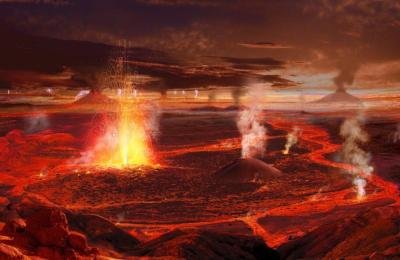
Siberian Traps. img src: Amed Post
In Siberia, Russia, there is a massive basalt province. This is a massive outflow of lava rock on a scale that has not been seen in the geological record since long before complex life arose. It appears to have been the worst volcanic eruption in the Phanerozoic. It is not like the eruptions of Mount Saint Helens. That is a volcanic eruption that was explosive and went on for a relatively short period. The Siberian Traps erupted continuously over millions of years and the rock still with us today covers an area over seven million square kilometers. This is roughly the same size as the continent of Australia. Imagine a sea of lava the size of Australia...
While that sea of lava, by itself, would have been a horrific event. The eruptions would have caused a mass extinction, but not nearly on the scale that it did. What the lava came into contact with is actually what drove the extinction. There were vast deposits of coal in Siberia at the time. These were laid down by all the indigestible plants from the Devonian and Carboniferous. The lava poured out of the volcanoes and then...ignited the coal.

Siberian Traps erupting in coal img src:PNAS
The coal, vast deposits of it, were burned. The burning was so extensive, it even helped drive down the oxygen levels on earth. The burning also caused a massive spike in the carbon dioxide content of the world. This was added to the incredible amounts of carbon dioxide the volcanoes were spewing into the atmosphere: there are actually large deposits of carbon within the Earth's mantle. Some of the carbon, probably most of it, is left over from the formation of the Earth. Some of it is from the Earth's plate tectonics, oceanic organisms make skeletons of calcium carbonate and this gets deposited on the ocean floor. Some of that is cycled into the mantle when the continents move through continental drift.
All of that carbon dioxide was spewed into the atmosphere. It warmed the world by over ten degrees celsius (18 deg F) in a short time by itself. It was made worse because the oceans were warmed. This caused the deposits of methane ice, known as methane clathrates to defrost. Methane is a far, far more potent greenhouse gas then carbon dioxide is. This caused a short and sharp temperature rise above the the ten degrees caused by carbon dioxide from the volcanoes. This warmed and killed far more life.
Aerobic photosynthesis requires an enzyme called RuBisCO. This enzyme breaks down permanently in high temperatures. This prevents plants from producing oxygen and kills them if the temperatures remain above that limit. During the Permian Extinction most of the world was too hot and killed most of the plant life.
Additionally, the oceans became much warmer. Warmer water cannot hold as much oxygen. If there is not enough mixing of the top and bottom waters in the ocean, it becomes stratified and then the bottom waters become anoxic. Once the top layers become less oxygenated, the level where the oxygen depleted water reaches becomes much higher. During the Permian Extinction, the oxygen depleted (anoxic) waters reached close to the surface. The warm loving, anoxic microbes of the time produced a chemical called hydrogen sulfide. This is extremely toxic to complex life. The waters became more poisonous and the algae and phytoplankton produced less oxygen, which then allowed the anoxic microbial life to live closer to the surface. That made a feedback loop that kept getting worse and worse.
Sea breezes could bring hydrogen sulfide inland and kill animals and plants there. Poseidon's breath was death.
Oceanic life only survived in pockets, refuges, from the vicious onslaught. It nearly perished altogether.
To make matters worse, that methane released from the melting ices had a second nefarious role to play. Methane, if there is sufficient amounts of it, will react with the ozone in the atmosphere. When the ozone is depleted, the levels of ultraviolet radiation jump considerably. They reach the lethal levels. Fossils from the time even show mutations in plants from unhealthy UV radiation to support this. UV levels on land would have been so bad as to kill many diurnal animals and numerous plants. Many of the survivors, like Lystrosaurus, appear to have been burrowing animals. This probably is why.
The volcanoes themselves were not quite done with their contribution. It appears the magma source the lava came from for the Siberian Traps had a very high halogen content. These elements include chlorine and fluorine, two chemicals that are wildly reactive. The volcanoes appear to have released a lot of halogen gases as well, adding to the hydrogen sulfide induced death with possible chlorine gassings and probable acid rains.
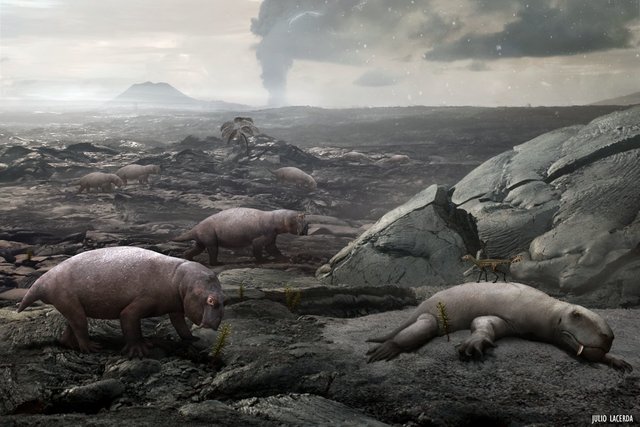
credit: Julio Lacerda
The heating and drying of the continental interior, due to the land largely being a single large supercontinent, made the inner reaches of the land, away from the sea, no refuge either. They became deserts harsher than Sahara or even the Empty Quarter in the Arabian Peninsula. The temperatures became so extreme, any salty water would have produced, yep, more halogen gases, killing any animal desperately thirsty enough to come close to them, even before drinking their salty, bleachy waters.
The extinction became so bad, had it gone on for another thousand years or more, complex life might have gone extinct. This may have happened before with the extinction of the Francevillian Biota, but that appears to have been related to the massive impacts like the Vredefort Impact. Had complex life gone extinct, the world would have slipped into another Boring Billion, more than likely, until if and when, but more likely if, complex life arose once more.
Had the methane clathrates not run out, had the hotspot driving the eruptions of the Siberian Traps not cooled, it is quite possible that all life could have been extinguished. Why? Because the continued heating could have been sufficient to trip the Earth's climate into a runaway greenhouse effect and turned the world into another hellacious Venus. The Permian Extinction was the closest the world has come to that state, at least in the last half billion years.
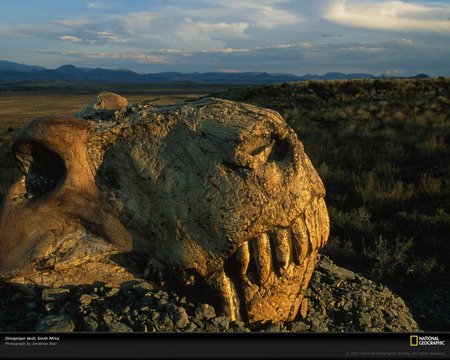
Credit: Jonathan Blair, img src: National Geographic
However, it did not. Otherwise, we would not be here discussing the event. Life, for a prolonged period, was badly crippled. The ecologies took up to ten to twenty million years to recover and most of the life that was left was a mere shadow of its former diversity. Gorgonopsids, most dicynondonts, the vast majority of their relatives the therapsids, were gone. So too were the massive and turtle-like pareiasaurs.
But!
As they say, life finds a way.
And in the aftermath, after the initial recovery, life exploded during the Triassic and produced strange new forms and strange new ways of interacting and strange new ways of moving that had not been before. That big burst of rancorous evolution with the dinosaurs arising, the pterosaurs taking flight and the appearance of true mammals were all part of the grand experiment - or wild party! if you will - of the Triassic. That would continue until 200 million years ago and the party ended with the Triassic Mass Extinction. And that will be the next post.
Extinction Event:
https://en.wikipedia.org/wiki/Extinction_event
Phanerozoic:
https://en.wikipedia.org/wiki/Phanerozoic
Permian Triassic Extinction:
https://en.wikipedia.org/wiki/Permian%E2%80%93Triassic_extinction_event
Gorgonopsia
https://en.wikipedia.org/wiki/Gorgonopsia
Once Upon the Permian: Gazes of Fear
http://thedragonstales.blogspot.com/2008/02/once-upon-permian-gazes-of-fear.html
Dicynodont
https://en.wikipedia.org/wiki/Dicynodont
Once Upon the Permian: Beaked Bites of a Lost Lineage
http://thedragonstales.blogspot.com/2008/03/once-upon-permian-beaked-bites-of-lost.html
Therocephalia
https://en.wikipedia.org/wiki/Therocephalia
Once Upon the Permian: Therocephalians, the Near Mammals Before Mammals
http://thedragonstales.blogspot.com/2015/09/once-upon-permian-therocephalians-near.html
Euchambersia
https://en.wikipedia.org/wiki/Euchambersia
Pareiasaur
https://en.wikipedia.org/wiki/Pareiasaur
Weigeltisauridae
https://en.wikipedia.org/wiki/Weigeltisauridae
Cynodont
https://en.wikipedia.org/wiki/Cynodont
Archosaur
https://en.wikipedia.org/wiki/Archosaur
Permian Triassic Extinction Event
https://en.wikipedia.org/wiki/Permian%E2%80%93Triassic_extinction_event
The Permian Extinction: What Caused the Great Dying?
http://thedragonstales.blogspot.com/2006/12/permian-extinction-what-caused-great.html
The Great Permian Extinction: When all life on Earth almost vanished
http://www.eartharchives.org/articles/the-great-permian-extinction-when-all-life-on-earth-almost-vanished/
Siberian Traps
https://en.wikipedia.org/wiki/Siberian_Traps
Explosive eruption of coal and basalt and the end-Permian mass extinction
http://www.pnas.org/content/109/1/59
Methane Clathrate
https://en.wikipedia.org/wiki/Methane_clathrate
Clathrate gun hypothesis
https://en.wikipedia.org/wiki/Clathrate_gun_hypothesis
RuBisCO
https://en.wikipedia.org/wiki/RuBisCO
Hydrogen sulfide
https://en.wikipedia.org/wiki/Hydrogen_sulfide
A possible cause of the end-Permian mass extinction: Lemon juice?
http://news.mit.edu/2013/permian-acid-rain-extinction-112513
Earth's Deadliest Mass Extinction Was Driven by Toxic Volcano Plumes
https://motherboard.vice.com/en_us/article/8xbjwk/earths-deadliest-mass-extinction-was-driven-by-toxic-volcano-plumes
New Theory On Largest Known Mass Extinction In Earth's History
https://www.sciencedaily.com/releases/2009/03/090330102659.htm
Francevillian Biota
https://en.wikipedia.org/wiki/Francevillian_biota
Boring Billion
https://en.wikipedia.org/wiki/Boring_Billion
Runaway Greenhouse Effect
https://en.wikipedia.org/wiki/Runaway_greenhouse_effect
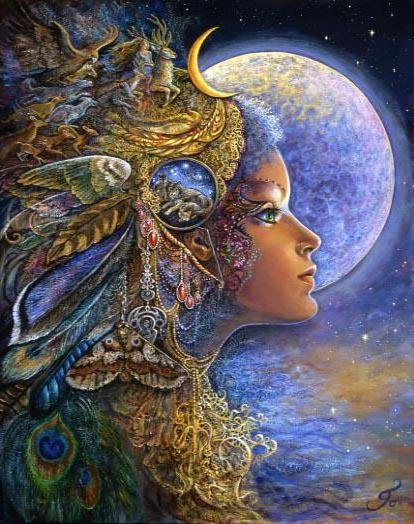
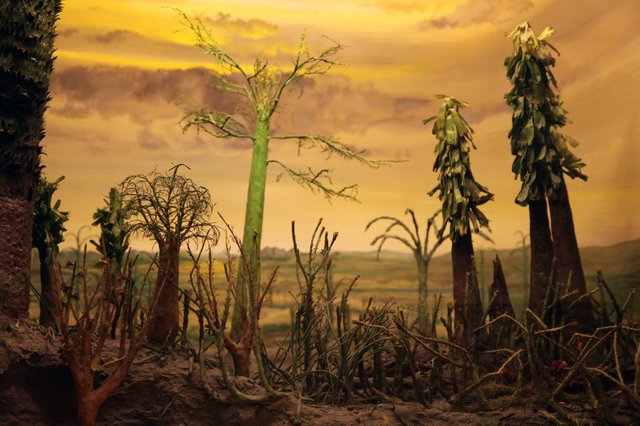
Great content ! i heard about the volcanic eruption in indonesia recently and it's quite serious. that's how mother nature works huh
Thank you.
There are different forms of volcanoes. The Siberian Traps were more like Iceland's Laki but on a vastly grander scale rather than the Indonesian eruptions. Those are more like Mt St Helens.
Hey, are your images free from copyright? Otherwise you may not be eligible for Steemstem votes
You have minor mistakes and typos, but nothing too much that Grammarly can't fix ( you will visually find those typos faster with it). Steem on. #steemrepair
You are always welcome to join us and get more recognition for your posts. You can find more information about geopolis here or join our Discord server.